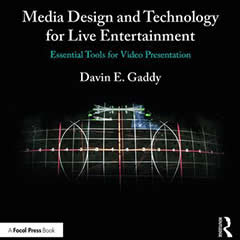This article talks about how we perceive color, and discusses the way we can generate colored light on the stage.
In order to talk about colored light on stage, we first want to understand a bit about how humans perceive color. The following is a pretty severe simplification. If you are really interested in the subject, read Colorimetry - Fundamentals and Applications This book will tell you more than you realized ever existed on the subject.
First of all, what is light? Visible light is a narrow band of electromagnetic radiation between the frequencies 400 and 700 nm. ( nm stands for nanometers a measure of the frequency). In our eyes we have three types of color receptors that are sensitive to different wavelengths of light. One set of receptors peaks at 445 nm ( Blue ) one at 535 nm ( Green) and one at 575 nm (Red ). When light hits these receptors, they send signals to the brain based on how strong the light is, and the frequency. The brain combines these signals to give us a sense of color. Note that these frequencies are not exactly those that we perceive as Red, Blue, Green but for the remainder of this document I am going to pretend that they are.

Note - I am having issues with this gif. The peaks of the three color receptors are at 445 - Blue. 535 - Green 575 - Red. Bluegreen is about 475. If someone knows how to give me a light background for the image, please fix it.
A key point here is to realize that the strength of each receptors signal to a specific frequency of light depends on how close the frequency is to the peak of the graph, and how bright the frequency is. If I hit the Blue receptor with 10 FC of light at 445 NM, it will get about the same signal as if I hit it with 20 FC at 480nm. The blue receptor is half as sensitive to light at 480NM than at 445NM.
How do we define what color a light is? There are actually two ways to consider the question. One is to look at the spectral distribution of the color. Here are some spectral charts for some various colors of gel which show the relative intensities of the light at various locations on the visible spectrum. Lets call this kind of definition the Spectral definition.



The other way is to define the color in terms of what the human brain perceives the color to be, IE how much signal the three receptors in your eye are receiving. If I see Blue at 75, Green at 75, Red at 10 I might perceive that as BlueGreen. I can generate that color in my brain by presenting my eye with light at 480nm, OR by providing Blue at 75, Green at 75, Red at 10, or any other combination of spectral frequencies that would excite my receptors appropriately. Lets call this kind of definition the Perceptual Definition.
This is the point where most books on the subject go into the weeds because they get excited about the fact that if you have three lights at these primary colors, you can shine them on a white surface and by varying the intensities of each color, the brain will generate all of the colors in the rainbow. In our field this just does not work because we are not generally lighting a white surface. ( Ok I am ignoring a white cyc RGB works pretty well on a white cyc.).
When we shine a light on a white surface, it reflects all of the light that hits it, but when we shine light on a colored surface, ( say a BlueGreen piece of fabric) it absorbs all light except the color we see ( in this case around 480 nm). Basically this means that if you are trying to light a piece of bluegreen fabric that absorbs all light outside of ( say) 475 and 485 nm, then you cannot light that fabric with frequencies of 445, 535, and 575 nm. The color will appear black. This is why costume designers tend not to like LED lights. A lot of colors appear dead as there is just not much light being reflected from the fabric for a number of colors.
So with that out of the way, how do we make color on stage. Three general ways.
Color Filters and Subtractive mixing both start with a continuous spectrum light. IE if you look at a graph of the spectral output of the unit with no filters, you will see all frequencies of visible light present. The really really nice thing about incandescent lamps is that they have a good continuous spectrum of light. They are generally deficient in the blue end o the spectrum, but a good compromise. Arc discharge lamps, while brighter per watt, usually are not continuous spectrum units. Fluorescent lamps generally are not continuous.
Color filters. You put a colored piece of plastic or glass in front of the beam of light that filters out the colors you dont want. The filter absorbs heat from the light that it is filtering out. Deep blue filters absorb so much of the red light and heat from the lamp that they can quickly melt. The really nice thing about filters is that the manufacturer can, but careful selection of the dyes in the filter, produce very complex spectral outputs. The downside of a color filter is that they are hard to change during a show, and you are limited by the number of colors you can produce. If you want a strong blue color, you will need lots of wattage, and you will be throwing away a lot of the output of your lamps.
Subtractive mixing. (Typically CMY ) You take three gradated filters Cyan, Magenta, Yellow ( These are the colors between the primary Red, Blue, Green ). If you move the filter into the beam of light, and watch the spectral output, you will see the frequencies change. For example, if you take a Cyan filter, and push it all the way in, you will see a peak intensity at 475 nm tailing off on each side. A key point is that you only have three knobs to tweak to get your output color. You can get a lot of colors, but you dont have the fine control that you can get with a gel.
Addative mixing. Originally we did addative mixing by taking an incandescent source, and filtering out all of the light but Red, Green, and Blue. By manipulating the levels we could generate a wide range of colors. Today we are moving towards LED units usually in RGB colors. The idea here is to have colors that will let us excite the receptors in our eye over the greatest range possible, and with the greatest control possible. Turns out that to do this, we need to be pretty narrow with the frequency of light we use for our RBG color. This means that if you look at a frequency distribution for a bluegreen color, you will see that there is not likely to be much if any light at 475nm. We will see light at 445 and 535 nm, but nothing at 475. This is why costumes generally look lousy under RBG addative mixing.
This issue with holes in the spectrum is why LED fixtures generally make the costume designers live really awful. If they have colors that reflect the light that the LED does not output there is no way to make that color show up. Some LED fixtures add an Amber channel to help with this issue, others add white. The best of breed is the Selador fixture that has seven different colors of LEDs. You can get a pretty even spectrum with this unit. LED fixtures are much more energy efficient and run cooler than incandescent units ( you are not turning the unwanted spectral frequencies into heat ) and they respond immediately to control changes. ( Sometimes this immediate response is a good thing. Sometimes it is not).
In order to talk about colored light on stage, we first want to understand a bit about how humans perceive color. The following is a pretty severe simplification. If you are really interested in the subject, read Colorimetry - Fundamentals and Applications This book will tell you more than you realized ever existed on the subject.
First of all, what is light? Visible light is a narrow band of electromagnetic radiation between the frequencies 400 and 700 nm. ( nm stands for nanometers a measure of the frequency). In our eyes we have three types of color receptors that are sensitive to different wavelengths of light. One set of receptors peaks at 445 nm ( Blue ) one at 535 nm ( Green) and one at 575 nm (Red ). When light hits these receptors, they send signals to the brain based on how strong the light is, and the frequency. The brain combines these signals to give us a sense of color. Note that these frequencies are not exactly those that we perceive as Red, Blue, Green but for the remainder of this document I am going to pretend that they are.
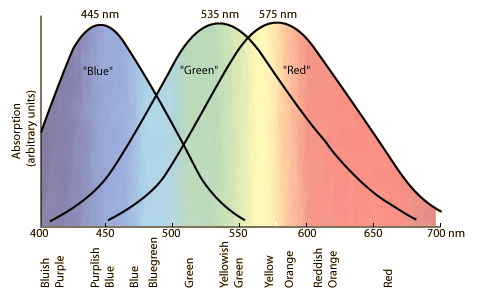
Note - I am having issues with this gif. The peaks of the three color receptors are at 445 - Blue. 535 - Green 575 - Red. Bluegreen is about 475. If someone knows how to give me a light background for the image, please fix it.
A key point here is to realize that the strength of each receptors signal to a specific frequency of light depends on how close the frequency is to the peak of the graph, and how bright the frequency is. If I hit the Blue receptor with 10 FC of light at 445 NM, it will get about the same signal as if I hit it with 20 FC at 480nm. The blue receptor is half as sensitive to light at 480NM than at 445NM.
How do we define what color a light is? There are actually two ways to consider the question. One is to look at the spectral distribution of the color. Here are some spectral charts for some various colors of gel which show the relative intensities of the light at various locations on the visible spectrum. Lets call this kind of definition the Spectral definition.
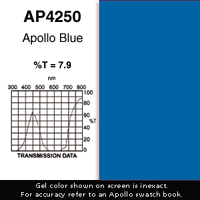
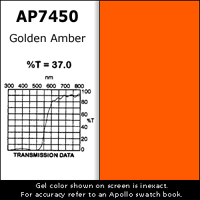
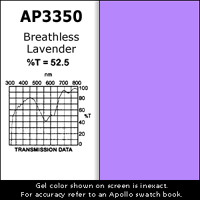
The other way is to define the color in terms of what the human brain perceives the color to be, IE how much signal the three receptors in your eye are receiving. If I see Blue at 75, Green at 75, Red at 10 I might perceive that as BlueGreen. I can generate that color in my brain by presenting my eye with light at 480nm, OR by providing Blue at 75, Green at 75, Red at 10, or any other combination of spectral frequencies that would excite my receptors appropriately. Lets call this kind of definition the Perceptual Definition.
This is the point where most books on the subject go into the weeds because they get excited about the fact that if you have three lights at these primary colors, you can shine them on a white surface and by varying the intensities of each color, the brain will generate all of the colors in the rainbow. In our field this just does not work because we are not generally lighting a white surface. ( Ok I am ignoring a white cyc RGB works pretty well on a white cyc.).
When we shine a light on a white surface, it reflects all of the light that hits it, but when we shine light on a colored surface, ( say a BlueGreen piece of fabric) it absorbs all light except the color we see ( in this case around 480 nm). Basically this means that if you are trying to light a piece of bluegreen fabric that absorbs all light outside of ( say) 475 and 485 nm, then you cannot light that fabric with frequencies of 445, 535, and 575 nm. The color will appear black. This is why costume designers tend not to like LED lights. A lot of colors appear dead as there is just not much light being reflected from the fabric for a number of colors.
So with that out of the way, how do we make color on stage. Three general ways.
- Color filters ( gel or dichroic filters) that filter out some frequencies of light similar to the way a physical object reflects some colors and absorbs others.
- Subtractive mixing where we have gradated dichroic filters that will filter out certain colors in a beam of light. By subtracting various colors from the beam, we can produce a wide range of color. Typically this is referred to as CMY ( cyan yellow magenta) mixing.
- Additive mixing where we have different sources at different frequencies ( Minimally Red, Green, and Blue or RGB). By controlling the intensity of each color, we can create a wide range of perceived colors.
Color Filters and Subtractive mixing both start with a continuous spectrum light. IE if you look at a graph of the spectral output of the unit with no filters, you will see all frequencies of visible light present. The really really nice thing about incandescent lamps is that they have a good continuous spectrum of light. They are generally deficient in the blue end o the spectrum, but a good compromise. Arc discharge lamps, while brighter per watt, usually are not continuous spectrum units. Fluorescent lamps generally are not continuous.
Color filters. You put a colored piece of plastic or glass in front of the beam of light that filters out the colors you dont want. The filter absorbs heat from the light that it is filtering out. Deep blue filters absorb so much of the red light and heat from the lamp that they can quickly melt. The really nice thing about filters is that the manufacturer can, but careful selection of the dyes in the filter, produce very complex spectral outputs. The downside of a color filter is that they are hard to change during a show, and you are limited by the number of colors you can produce. If you want a strong blue color, you will need lots of wattage, and you will be throwing away a lot of the output of your lamps.
Subtractive mixing. (Typically CMY ) You take three gradated filters Cyan, Magenta, Yellow ( These are the colors between the primary Red, Blue, Green ). If you move the filter into the beam of light, and watch the spectral output, you will see the frequencies change. For example, if you take a Cyan filter, and push it all the way in, you will see a peak intensity at 475 nm tailing off on each side. A key point is that you only have three knobs to tweak to get your output color. You can get a lot of colors, but you dont have the fine control that you can get with a gel.
Addative mixing. Originally we did addative mixing by taking an incandescent source, and filtering out all of the light but Red, Green, and Blue. By manipulating the levels we could generate a wide range of colors. Today we are moving towards LED units usually in RGB colors. The idea here is to have colors that will let us excite the receptors in our eye over the greatest range possible, and with the greatest control possible. Turns out that to do this, we need to be pretty narrow with the frequency of light we use for our RBG color. This means that if you look at a frequency distribution for a bluegreen color, you will see that there is not likely to be much if any light at 475nm. We will see light at 445 and 535 nm, but nothing at 475. This is why costumes generally look lousy under RBG addative mixing.
This issue with holes in the spectrum is why LED fixtures generally make the costume designers live really awful. If they have colors that reflect the light that the LED does not output there is no way to make that color show up. Some LED fixtures add an Amber channel to help with this issue, others add white. The best of breed is the Selador fixture that has seven different colors of LEDs. You can get a pretty even spectrum with this unit. LED fixtures are much more energy efficient and run cooler than incandescent units ( you are not turning the unwanted spectral frequencies into heat ) and they respond immediately to control changes. ( Sometimes this immediate response is a good thing. Sometimes it is not).
- With RGB LED lighting, I can produce a pretty wide range of colors but colored fabric and faces will tend to look wrong because of the spikey nature of the spectral output. I can change colors and change levels instantly.
- With CMY I can produce a fairly wide range of colors. Colored fabric and faces will look as I expect them to look because the spectral output is more even. Colors can be changed quickly.
- With Gel, I can produce a huge range of colors, and can select much more complex spectral distributions than I can with CMY or LED. I cant fade from one color to another as I can with CMY or LED although I can use a scroller.
This page has been seen 1,445 times.
-
-
Created by on
-







